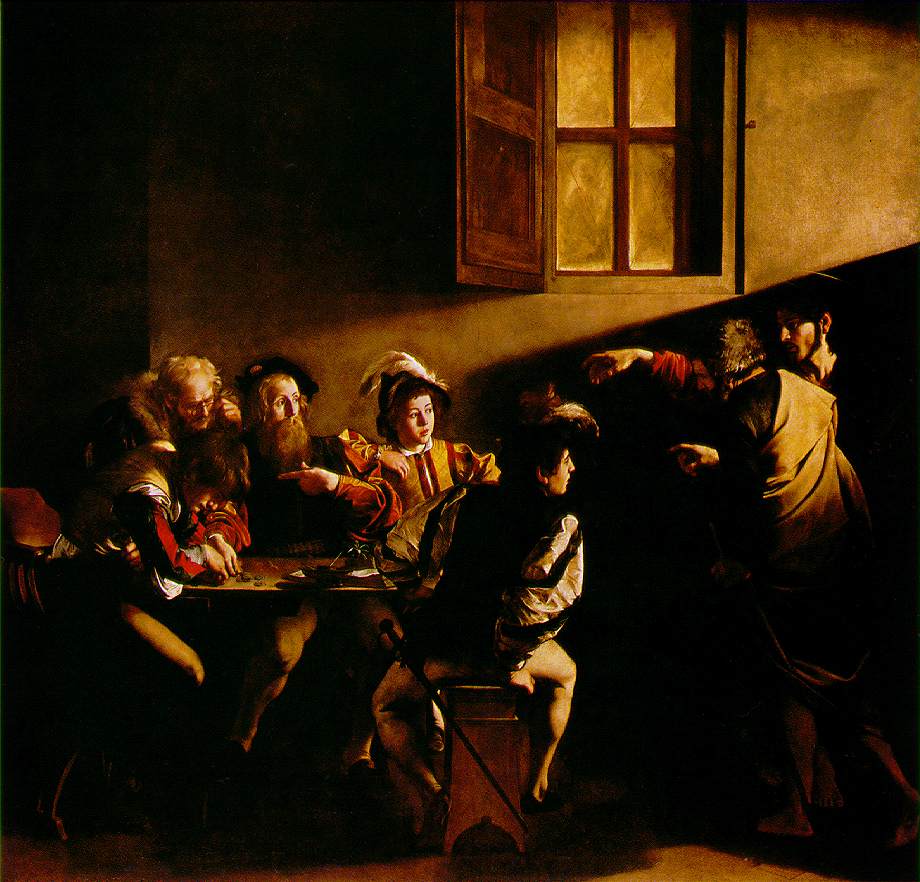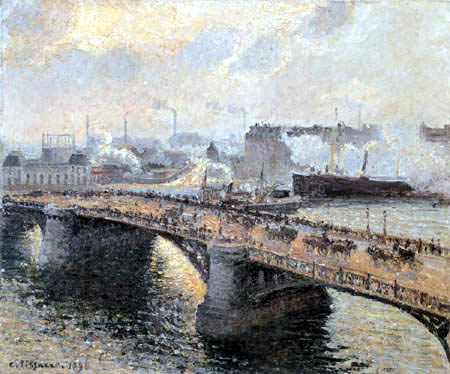A is for Art
because everyone needs a little art in their lives
Sunday, March 6, 2011
Divan Japonais
Henri Toulouse-Lautrec, a post-impresstionist, was born into an aristocratic French family in 1864. cast out early in life because of a birth defect (likely the result of inbreeding), he found a home amongst the bohemian artists and performers in Montmartre. he made a living creating posters such as this one, which advertises a cabaret performance. all of western Europe was, at this point, enamored of Japanese culture, a result of the recent opening of Japan and an outpouring of Japanese goods.
Divan Japonais was painted in 1893 and is housed at the MFA Boston.
Wednesday, December 29, 2010
The Calling of Saint Matthew
Michelangelo Merisi da Caravaggio, known simply as Caravaggio, was an Italian painter in the 16th century CE. he is known for his manipulation of light, or chiaruscuro (literally: light-dark). his paintings are often predominantly dark, with a stark, almost blinding light illuminating his subjects. his models were the common people that surrounded him on a daily basis. they could have been prostitutes or artists; what they were not were the clean, angelic, peaceful people that usually graced the canvases of similar religious paintings.
this painting, "The Calling of Saint Matthew", painted 1599-1600, depicts the moment that Christ calls Matthew to become one of his disciples.
happy new year!
<3a
Monday, December 13, 2010
Frescoes in the Villa of the Mysteries, Pompeii, Italy
when I was in high school, our art department went on a trip to Italy. one of the highlights of the trip (and there were many) was visiting Pompeii. of course, my camera died about 10 minutes after entering the city, something I am still bitter about to this day.
the picture above is an image from the so called "Dionysian Mystery Frieze" from the Villa of the Mysteries and dates to about 60-50 BCE. it is thought to depict initiation rites into the Cult of Dionysus. Dionysus, also called Bacchus, is the god of wine, madness, ecstasy and epiphany.
what is most interesting about these paintings, to me at least, is that they are true frescoes. this means that the paint was applied while the plaster was still wet. this must be done quickly and in small patches so that the plaster does not dry before the artist has time to paint the images. the same technique was used by Michelangelo to paint the ceiling of the Sistine Chapel. it is likely that the frieze has survived for so long because of this technique.
to see the rest of the frieze and learn more about the villa, you may want to visit this site.
<3a
Wednesday, December 8, 2010
I made it to the de Young's Post-Impressionist exhibit!
I went to the de Young's exhibit "Van Gogh, Gauguin, Cezanne and Beyond" over the weekend. it was absolutely stunning. beautifully edited, wonderfully displayed, and very informative, if a little crowded.
the first painting a visitor passes as they make their way around the first room is an unassuming little painting by Pissarro of the Pont Boieldieu. as you get closer you realize what a beautiful painting it is.
Pissarro, one of the original Impressionists, and an extremely under appreciated one in my opinion, tended to paint the working class, in contrast with the middle-class subjects of most Impressionists. he was later influenced by Signac, a Pointalist, and his use of color theory, but this painting is wholly Impressionist.
if you happen to be in San Francisco before January 18th, you MUST go see this exhibit. and while you're there, try to head over to the Legion of Honor's "Japanesque" exhibit, about the influence of Japanese wood block prints on Impressionist art. that exhibit ends on January 8th, and I'm desperately trying to make time in my schedule to see it.
<3a
Wednesday, December 1, 2010
Portrait de Angel Fernandez de Soto
in case you haven't heard, an unprecedented 271 paintings by Picasso were found the day before yesterday. a french man and his wife came forward with the paintings, which the say were given to them by the artist and his wife. they have been kept in the couples garage and are estimated to be worth roughly $80 million.
this paintings, which was not one of the ones recovered, is the Portrait de Angel Fernandez de Soto. the painting dates to 1903. de Soto, who shared a studio with Picasso on more than one occasion, is shown in a bar with a glass of absinthe and a pipe, thus the alternate name for the painting: The Absinthe Drinker. de Soto was later killed in the Spanish Civil War.
for more information on the found paintings, check out this article from the Telegraph. I'll be interested to see how the debate about how the couple came to own the paintings unfolds!
<3a
Wednesday, November 24, 2010
Hunters in the Snow
so currently my little part of California is freezing. I realize this is not exactly a phenomenon and that most of the country has been very cold for quite some time now, but it's still shocking to me, probably because I dont have a proper heater.
anyway, it made me think of this painting, Pieter Bruegel the Elder's Hunters in the Snow. Bruegel was a Flemish painter in the 16th century. he is known for depicting daily Flemish peasant life, and also for his allegorical paintings. like Shakespeare he often painted comical scenes of peasants. they appear almost as farces, but the lack of pretense in the lower classes of the time made them an easy target for Bruegel's commentary on human nature.
in case you were wondering, there is indeed a Pieter Bruegel the Younger also. maybe I'll do a post on him later.
have a great Thanksgiving, and stay warm!
<3a
Saturday, November 20, 2010
Hall of the Bulls, Lascaux
I have always been fascinated by prehistoric art. the lengths that these early people went to in order to depict these images is truly astounding. they are usually found deep inside caves and high above where any human could reach on their own. the mystery surrounding their purpose is intriguing too. clearly the images were of great importance, but why? were they religious, as some people suggest, were they involved in some sort of initiation rite? or were they intended for something else entirely?
this is a photo of one of the most well known examples of prehistoric art: the hall of the bulls in Lascaux, France. while it is no longer open to visitors, due to preservation efforts, there is a replica and a museum situated right next to the original cave.
<3a
ps, excuse my short, not complex sentences. I'm still sick, and in a caffeinated/sudafed induced fog.
Subscribe to:
Posts (Atom)






